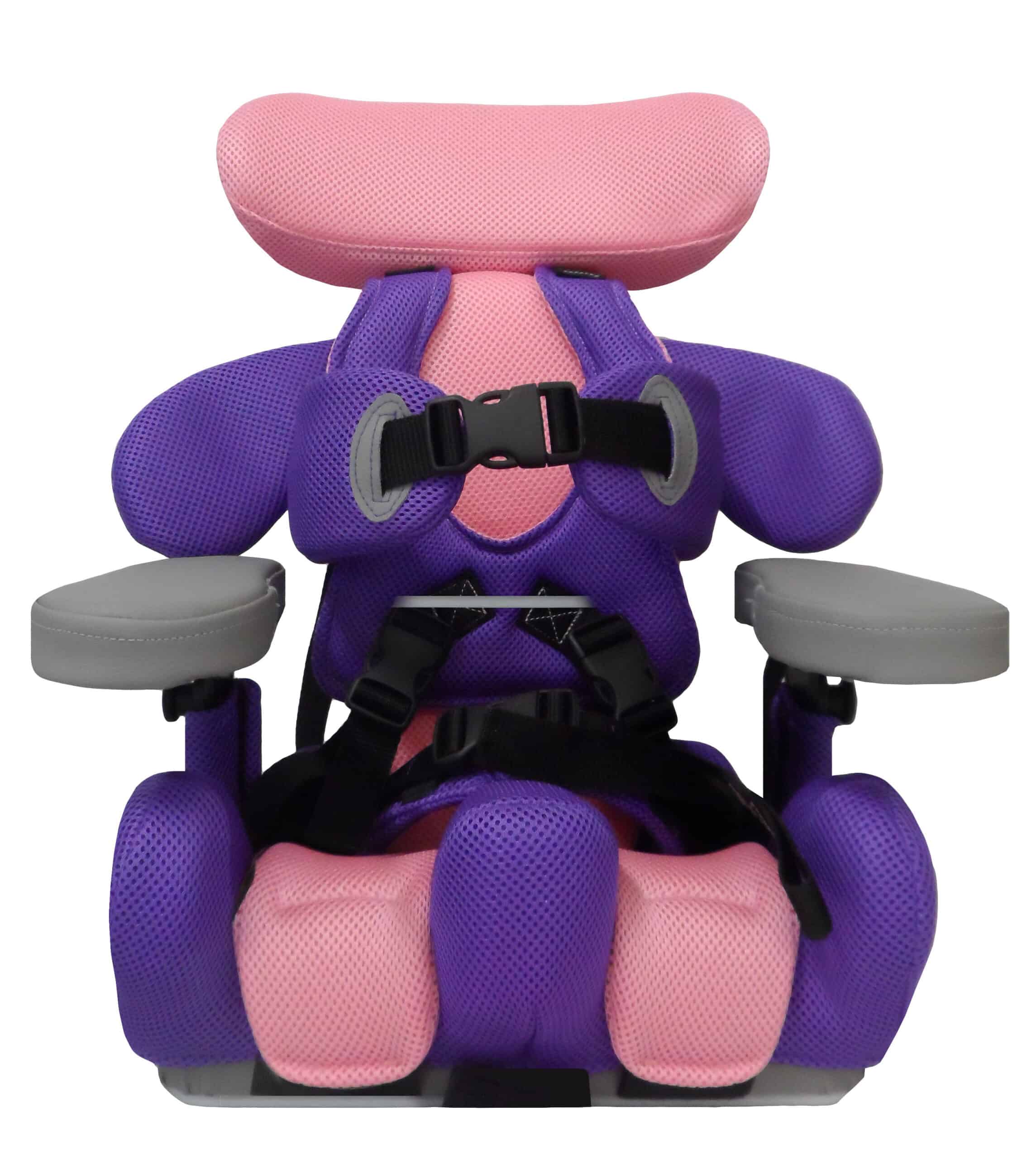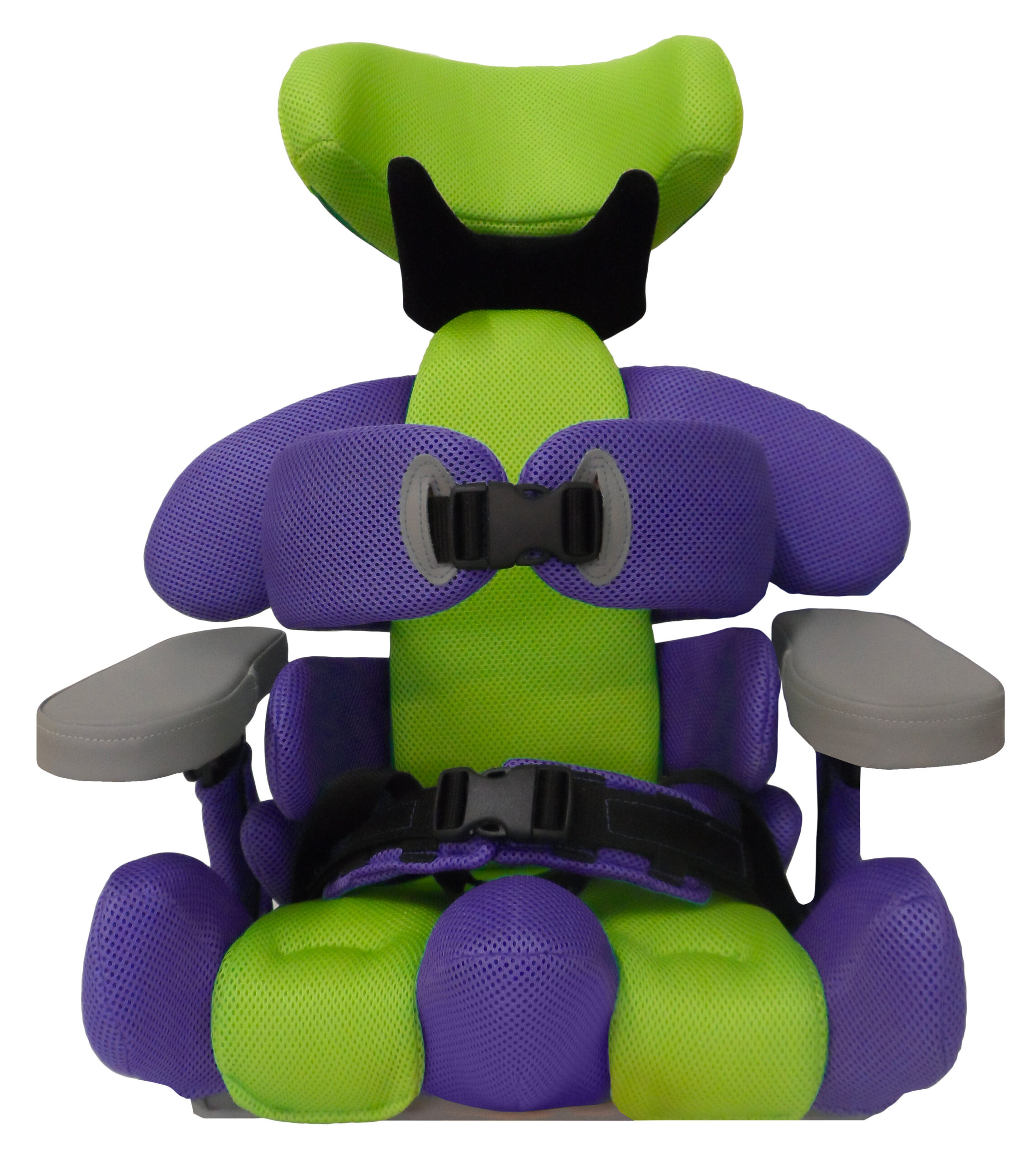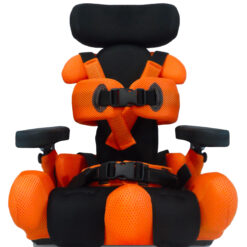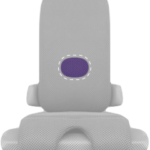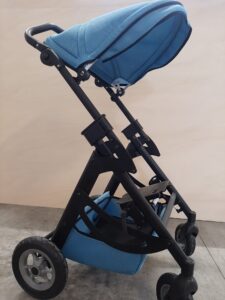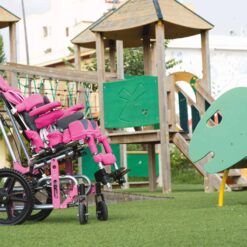Description
The Abbraccio® Tailored Seating Systems welcomes your baby from 4 months on by offering the pleasant sense of protection and support that your arms give them. Just as each hug is unique and unrepeatable, so this simple but effective chair is tailor-made in order to meet the specific needs of your child. Your child grows and Abbraccio® can be changed at any time by a qualified technician in order to promptly accommodate any changes and any new requirements.
Every smallest detail, from the seat to the headrest, from the armrests to the colour will be chosen together with you and the clinical team that supports you, with the aim of giving your child the best in terms of posture, comfort and aesthetics in order to help you achieve small and great achievements in complete autonomy.
Technical Features
Seat & Back:
The Abbraccio® is basically a system consisting of a seat and a backrest, built with elements arranged directly on the patient. The back support can be reclined to allow varying the angle of inclination of the back/sacral area. The modules and calibrations allow any configuration changes and postural seat adjustments according to the evolution of the child, in particular, the adjustment range for the width and the depth exceeds 15 cm. The fabric that lines the Abbraccio® is made of a soft, breathable, removable and washable material. As you can see from the picture, this is the basis on which we add the various components in order to ensure the child’s posture and comfort; objectives which, due to the severity of the diagnostic picture of the boy/girl, often cannot be achieved only with the seat.
Posture Wedge Cushion:
The Abbraccio® wedge is built after taking as many as 10 measurements and is not a simple retractor but an actual system that stabilizes and postures the child. This wedge-shaped and fully customized retractor can be modified at any time in accordance with the concept of modularity, which inspires Abbraccio®; covered by breathable material it is removable and washable.
Pelvis Immobilizer:
The lateral pelvis containment elements are made to measure and can be adjusted at any time along any plane: sagittal, frontal and transverse. They are made on the basis of the overall postural project and can either be a simple containment for the pelvis or become prominent postural immobilizers that reach up to join the wedge front retractor. The pelvis containment elements, such as the trunk support, are made with an aluminium core and a soft covering lined with breathable, removable and washable fabric.
Pelvic Strap:
The pelvic strap ensures a precise and stable positioning of the pelvis thanks to the different possibilities of fixing the belt on the base. This type of adjustment can also be modified at any time. As an alternative to the Abbraccio® belt (2 or 4 points), all commercial belts can also be applied.
Adjustable Backrest:
The height adjustment of the backrest is provided by inserting two, three or more brackets each 20 or 30 cm long which sliding along each other ensure an extension of more than 20 cm.
Lumbar Support:
The materials and the dimensions of the support are chosen in relation to the postural corrections to be made.
Side Support:
From a technical point of view, the side supports are the most enveloping element of the Abbraccio® whilst representing the most comfortable and reassuring one for the child. The child, in fact, in addition to receiving an important postural containment, receives a protection and safety proprioceptive input nearly equivalent to his parents’ arms. The side supports, like every other element constituting the Abbraccio®, are completely tailor-made with an aluminium core and a soft covering with breathable, removable and washable fabric. The Abbraccio® side supports, despite being custom built, are in any case modular and adjustable along each plane: sagittal, frontal and transversal.
Belt for Side Support:
The chest strap placed between the two side supports, offers a further restraint on the chest which with the side supports helps in giving an important proprioceptive input.
Shoulder Containment:
This accessory, matched with the position and shape of the armrest, ensures containing the shoulders, particularly in postural changes as, for example, when increasing the degree of tilting.
Headrest:
The Abbraccio® headrest is custom built and adjustable in height, it provides adequate support for the child’s head because it reflects every aspect of the physiological characteristics and pursues postural objectives. The support module therefore provides height adjustment, but also adjustments for the antero-posterior, lateral and tilting directions and is lined with soft, breathable, removable and washable fabric.
Neck Positioning:
The soft under jaw collar technically reproduces the doctor’s or therapist’s hand that creates the postural containment he wants to obtain for the child’s head with his gestures during the evaluation phase. The soft under jaw collar is entirely tailored made in relation to the child’s measurements, but may be changed at any time to accommodate developments subsequent to delivery.
Vest:
The vest is adjustable in height, both in the upper part and in the lower part, through a belt-pass which stabilizes the trunk without crushing the shoulders, but on the contrary it postures and fixes them in the best wanted position.
Armrests:
The armrests are modelled for containing the forearm, with pre-set modular elements that allow height, width, inclination and antero-posterior direction adjustments. The upper part of the armrest is covered with a washable material which allows care givers to keep the support clean with a simple wipe with a clean sponge, while the rod coating is removable and washable.
Tray:
The Abbraccio® tray is also built on the basis of measurements taken in the testing phase and is covered with a water-repellent and washable material. The shape and the containment edge are customized to specific rehabilitation needs.
Indoor Base

| Technical Details |
| Length |
69 cm |
| Width |
52 cm |
| Minimum height |
29,5 cm |
| Maximum height |
60,8 cm |
| Tilt adjustment |
0 – 27° |
| Weight |
12,6 Kg |
| Small footrest weight |
1 kg |
| Small footrest weight |
1,5 kg |
| Maximum dimensions with closed footrest |
75 x 52 cm |
| Maximum dimensions with opened footrest |
90 x 52 cm |
If you want your child to be always near you, welcomed and supported, but at the same time you need to give him and yourself autonomy to perform daily activities at home, the indoor base is the right solution for you. This base is easily and quickly height adjustable in order to adjust the chair to any work surface, it can climb up to the kitchen table, but it can also go down to the floor in order to adjust its feet on the floor to the height of siblings or friends. The indoor base may also be tilted, allowing changes of posture that can facilitate the various activities of daily living, from food to rest.
Outdoor Base

| Technical Details |
| Length |
74 cm |
| Width |
51,5 cm |
| Minimum height |
61 cm |
| Maximum height |
123 cm |
| Tilt adjustment |
3 – 60° |
| Weight |
14,5 Kg |
| Small footrest weight |
1 kg |
| Large footrest weight |
1,5 kg |
| Maximum dimensions with closed footrest |
100 x 51,5 cm |
| Maximum dimensions with opened footrest |
135,5 x 51,5 cm |
If it’s sunny and your child is well, what could be better than a nice walk outdoors to recharge energy, and here is a light and handy base that you can take out safely. The outdoor base has a single and adjustable handle for pushing Abbraccio® with one hand, a lever is also positioned on the handle through which you can change the inclination of the seat and allow your child to rest at the park or at the supermarket simply and quickly.
Certification
Reference Standards
This article has been designed and manufactured in compliance with the safety requirements
laid down in Directive 93/42/EEC of 06/14/93 (class I) and subsequent amendments and additions (Directive 2007/47/EEC) concerning medical devices.
Intended use
Type: device for postural support.
Personnel in charge of adjustments: professional operators and doctors.
Supervision and responsibility: the treating physician.

Identification:
1. Name and address of the manufacturer.
2. Refer to the user manual.
3. Catalogue identification code.
4. Serial number.
5. Manufacturing Date.
6. Upholstery fabric.
7. Washing instructions.
8. EC mark.
9. Maximum patient weight







